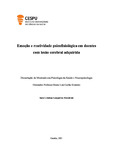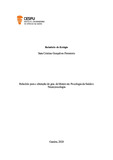| dc.contributor.advisor | MONTEIRO, LUÍS MANUEL COELHO | |
| dc.contributor.author | Perestrelo, Sara Cristina Gonçalves | |
| dc.date.accessioned | 2021-07-23T14:37:24Z | |
| dc.date.available | 2021-07-23T14:37:24Z | |
| dc.date.issued | 2021 | |
| dc.identifier.uri | http://hdl.handle.net/20.500.11816/3640 | |
| dc.description.abstract | As sequelas provenientes de uma lesão cerebral são inúmeras e diversificadas, originando alterações a nível físico, cognitivo e psicológico. Posto isto, a presente investigação procura compreender o impacto que a lesão cerebral tem a nível da cognição, capacidade avaliativa e no processamento emocional em sujeitos com lesão cerebral adquirida (LCA). Para tal, recorreu-se à visualização de estímulos emocionógenos, registando os autorrelatos com recurso ao Self Assessment Manikin (SAM) e às suas escalas de valência e ativação e registou-se simultaneamente as medidas fisiológicas periféricas.
Metodologia: Avaliamos 98 indivíduos, em que 65 pertenciam ao grupo de LCA (M= 42,05; DP=10,87), e os restantes 33 pertenciam ao grupo controlo (M= 29,23; DP= 15,60) de modo a proceder à comparação entre os dois grupos. Estes foram expostos a visualização de 12 estímulos do International Affective Picture System (IAPS), de três condições emocionais distintas, (agradável, neutro e desagradável). No decorrer da visualização, cada indivíduo classificou cada estímulo nas duas escalas fornecidas, sendo feito o registo simultâneo de medidas fisiológicas periféricas.
Resultados: No que concerne à valência, o grupo de LCA avaliou os estímulos referentes à condição emocional (CE) desagradável de forma mais desagradável, quando comparados com o GC. No que refere à ativação observou-se que na presença de estímulos agradáveis e neutros, destaca-se a existência de valores superiores no grupo LCA face ao GC. Na reatividade eletrodérmica, verificou-se que na CE agradável e desagradável, os valores de reatividade são inferiores no grupo de LCA quando comparados com o GC. Perante a variabilidade cardíaca apuramos que os valores de variabilidade são similares nos dois grupos em estudo, não existindo valores significativos.
Discussão/Conclusão: Tendo em consideração a relevância do presente estudo, e de acordo com os resultados obtidos, é bastante importância dar seguimento ao mesmo e ampliá-lo de modo obtermos dados mais concretos face a esta temática. | pt_PT |
| dc.description.abstract | The sequelae resulting from a brain injury are innumerable and diverse, resulting in alterations at the physical, cognitive and psychological levels. That said, the present investigation seeks to understand the impact that brain injury has on cognition, evaluative capacity and emotional processing in subjects with acquired brain injury (ABI). For this, it was used the visualization of emotional stimuli, recording the self-reports using the Self-Assessment Manikin (SAM) and its valence and activation scales and simultaneously recording the peripheral physiological measures.
Methodology: We evaluated 98 individuals, 65 of whom belonged to the ABI group (M = 42.05; SD = 10.87), and the remaining 33 belonged to the control group (M = 29.23; SD = 15.60) from so as to make a comparison between the two groups. These were exposed to the visualization of 12 stimuli of the International Affective Picture System (IAPS), of three different emotional conditions, (pleasant, neutral and unpleasant). During the visualization, each individual classified each stimulus on the two scales provided, with the simultaneous recording of peripheral physiological measures.
Results: With regard to valence, the ABI group evaluated the stimuli related to the emotional condition (EC) unpleasant in a more unpleasant way, when compared to the CG. With regard to activation, it was observed that in the presence of pleasant and neutral stimuli, the existence of higher values in the ABI group stands out compared to the CG. In electrodermal reactivity, it was found that in pleasant and unpleasant EC, the reactivity values are lower in the ABI group when compared to the CG. In electrodermal reactivity, it was found that in pleasant and unpleasant EC, the reactivity values are lower in the ABI group when compared to the CG. Given the cardiac variability, we found that the variability values are similar in the two groups under study, with no significant values.
Discussion / Conclusion: Taking into account the relevance of this study, and according to the results obtained, it is very important to follow it up and expand it in order to obtain more concrete data regarding this theme. | pt_PT |
| dc.language.iso | por | pt_PT |
| dc.rights | info:eu-repo/semantics/openAccess | pt_PT |
| dc.subject | Valência | pt_PT |
| dc.subject | Ativação | pt_PT |
| dc.subject | Emoção | pt_PT |
| dc.subject | Lesão Cerebral Adquirida (LCA) | pt_PT |
| dc.subject | Reatividade Eletrodérmica | pt_PT |
| dc.subject | Variabilidade Cardíaca | pt_PT |
| dc.title | Emoção e reatividade psicofisiológica em doentes com lesão cerebral adquirida | pt_PT |
| dc.type | info:eu-repo/semantics/masterThesis | pt_PT |
| dc.identifier.tid | 202736857 | pt_PT |
| thesis.degree.name | Mestrado em Psicologia da Saúde e Neuropsicologia | pt_PT |


